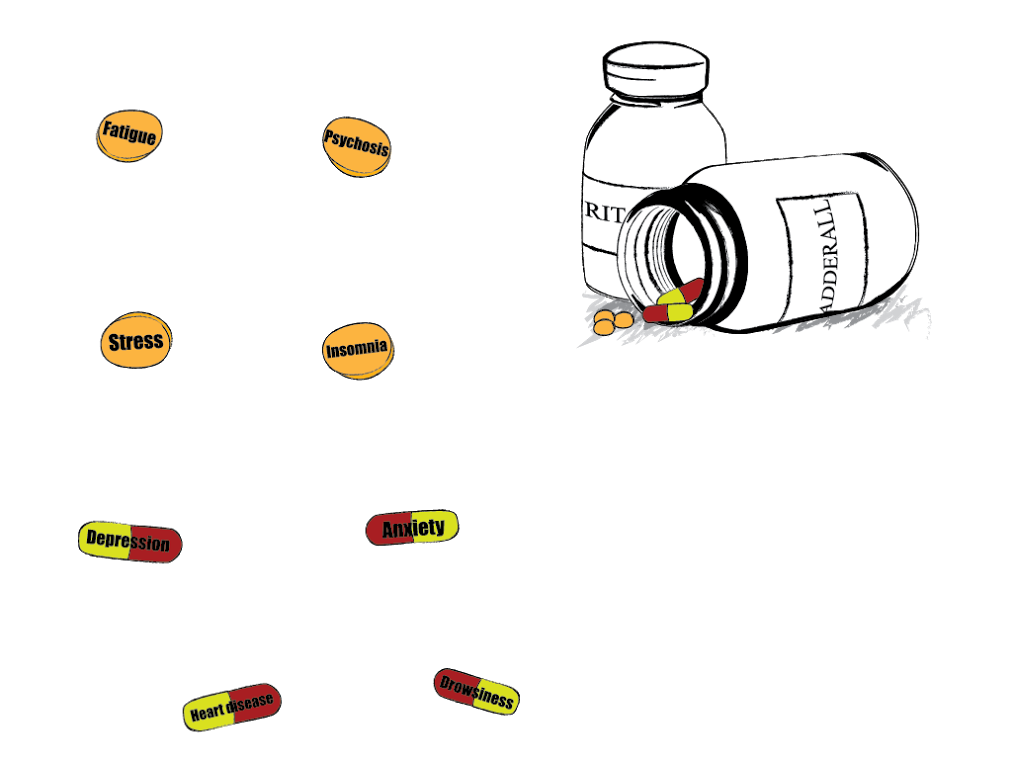
Anthony Motroni
A 2013 study, from the National Bureau of Economic Research, shows that medications used to treat ADD and ADHD do not improve the grades of people who take them without a prescription.*
A separate study, Coalition To Prevent ADHD Medication Misuse, showed that although the study showed that 43 percent of the respondents thought ADD and ADHD medications were performance enhancers, experts say the drugs do not necessarily improve the grades of those who take them and also carry health risks that many students may not expect.
There are several different medications available in this class such as adderall, vyvanse and ritalin. These can come in instant and extended release variants as well, which carry their own specific health risks.
“Prolonged, unsupervised use can result in increased risk of anxiety, panic attacks and psychosis,” said Victor Schwartz, the medical director at the Jed Foundation, an organization that promotes positive emotional and mental health.
Schwartz went on to say that all of the medicines in this class are stimulants, meaning they can be linked to increases in heart rate, blood pressure and insomnia. These effects are already dangerous, especially if people have undiagnosed conditions such as heart disease. When taken consistently, these drugs can be very addictive.
ADD and ADHD medications can be short-term and long-term acting. Short-term acting medications are absorbed into the body quickly, which causes a quicker physiological effect. The long-term acting medications tend not to result in immediate physiological effects, according to Schwartz.
Another danger associated with these types of medications is the possibility of flashback side effects.
“If a person experiences a panic attack while on the drug, there is a chance that those panic attacks can continue going forward even without the drug on board,” Schwartz said.
Ann Quinn-Zobeck, a senior director of the BACCHUS Initiatives of the organization of National Association of Student Personnel Administrators, agreed with Schwartz.
“Any time you take a prescription drug without supervision, you are risking some kind of physical side effect,” Quinn-Zobeck said. “In the case of stimulants, these side effects can include fatigue which can lead to depression and anxiety.”
The National Association of Student Personnel Administrators’ mission is to support collegiate peer educators and advisors by empowering students and student affairs administrators to create healthy and safe campus environments.
The distinction between taking a drug while under the supervision of a doctor and self-dosing is becoming more important as most students are not getting these drugs from doctors, but from their friends, according to the Harris Poll study.
When students self-dose they ignore many things that doctors consider when prescribing certain medications such as body type, stress levels and their requisite active timeframes.
“I’m not sure how these types of medications affect people’s ability to retain information but I think it makes them feel like they are doing better, that confidence could conceivably improve their performance,” said Austin Pate, a junior studying criminology.
Buying from friends or other students also carries the added danger of depriving the students who really need the medication.
Hunter Lowery, a senior studying biochemistry, said that he believes this problem could be avoided if the medication was made more available.
“The medication should be more available over the counter, but there should be regulations regarding the quantity and frequency in which these types of medication are bought,”
Lowery said.
Quinn-Zobeck said that raising awareness among students is the best way to prevent the misuse of these medications. “Education — students talking to other students is the most important thing,” she said.
The data collected in the study was produced from voluntary response survey questions that reflected students’ perceptions of misuse. The survey asked what students thought about using medication without a doctor’s instructions, rather than a scientific analysis of behavioral tendencies.
Harris Polls, on behalf of the CPAMM, conducted the study.
There were 2,056 participants who responded to the survey. Their data was weighted where necessary to reflect the nature of responses when applied to the larger population.
*On 9/22 the Technician added details about the study mentioned for clarification purposes.